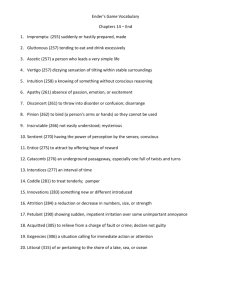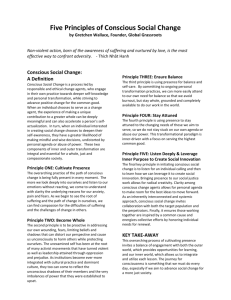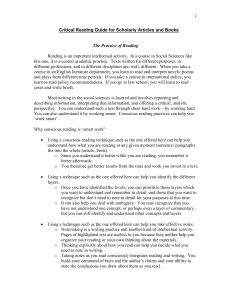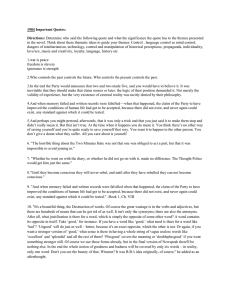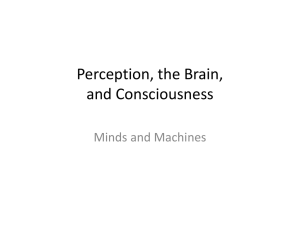c h a p t e r 1 3
advertisement
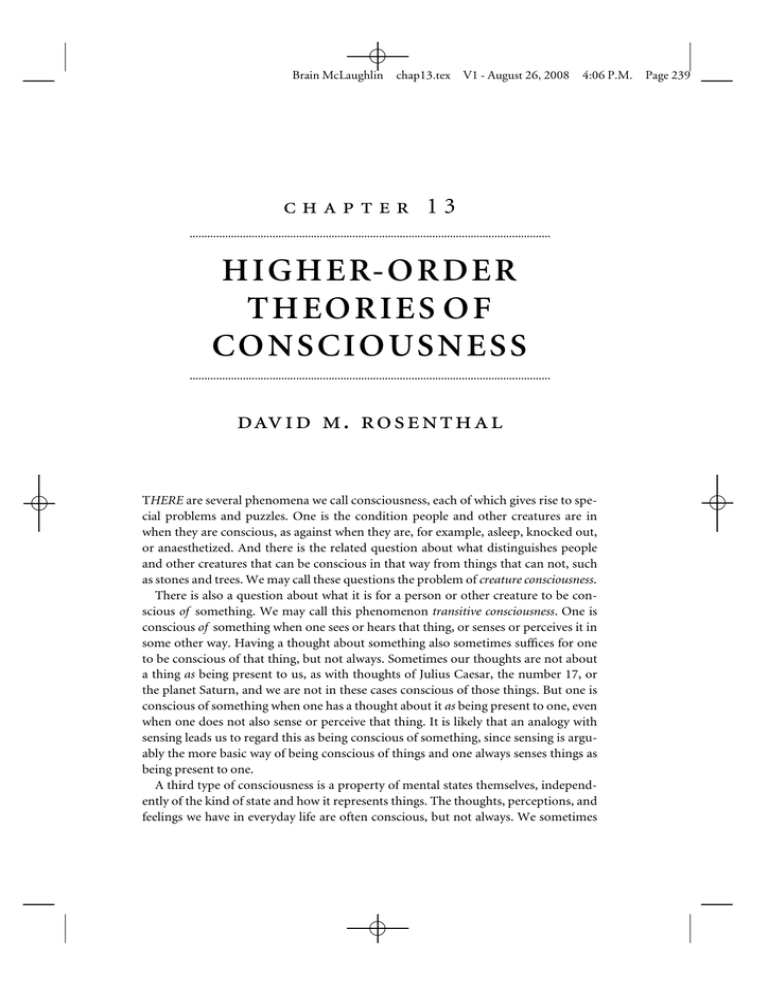
Brain McLaughlin chap13.tex V1 - August 26, 2008 4:06 P.M. Page 239 chapter 13 •••••••••••••••••••••••••••••••••••••••••••••••••••••••••••••••••••••••••••••••••••••••••••••••••••••••••••••••••••••••••• HIGHER-ORDER THEORIES OF CONSCIOUSNESS •••••••••••••••••••••••••••••••••••••••••••••••••••••••••••••••••••••••••••••••••••••••••••••••••••••••••••••••••••••••••• THERE are several phenomena we call consciousness, each of which gives rise to special problems and puzzles. One is the condition people and other creatures are in when they are conscious, as against when they are, for example, asleep, knocked out, or anaesthetized. And there is the related question about what distinguishes people and other creatures that can be conscious in that way from things that can not, such as stones and trees. We may call these questions the problem of creature consciousness. There is also a question about what it is for a person or other creature to be conscious of something. We may call this phenomenon transitive consciousness. One is conscious of something when one sees or hears that thing, or senses or perceives it in some other way. Having a thought about something also sometimes suffices for one to be conscious of that thing, but not always. Sometimes our thoughts are not about a thing as being present to us, as with thoughts of Julius Caesar, the number 17, or the planet Saturn, and we are not in these cases conscious of those things. But one is conscious of something when one has a thought about it as being present to one, even when one does not also sense or perceive that thing. It is likely that an analogy with sensing leads us to regard this as being conscious of something, since sensing is arguably the more basic way of being conscious of things and one always senses things as being present to one. A third type of consciousness is a property of mental states themselves, independently of the kind of state and how it represents things. The thoughts, perceptions, and feelings we have in everyday life are often conscious, but not always. We sometimes david m. rosenthal Brain McLaughlin 240 chap13.tex V1 - August 26, 2008 4:06 P.M. Page 240 david m. rosenthal sense things subliminally, and sometimes our thoughts and desires occur outside our stream of consciousness. Arguably the most pressing and challenging problem about consciousness is to explain what the difference is between mental states that are conscious and those that are not. We may call this the problem of state consciousness. It is this question that higher-order theories of consciousness address. 13.1 Higher-order Theory and the Transitiv ity Principle Descartes, Locke, and their contemporaries never use ‘conscious’ as a one-place predicate applied to mental states. Locke does speak of the totality of an individual’s conscious states as a consciousness, and he maintains that personal identity consists in the identity of such a consciousness (Locke 1700/1975: II. xxvii. 19). But he does not describe the thoughts, feelings, or perceptions themselves as conscious. What these authors do urge is that whenever these states occur in somebody, that individual is conscious of them. Descartes famously adds that this consciousness is unmediated; one is immediately conscious of all one’s thoughts whenever they occur (Descartes 1964–1975: vii. 246). It is not until the latter part of the nineteenth century that theorists come to recognize that some mental states do occur of which we are wholly unaware. And, because of the resulting need to mark the difference between those mental states and those we are conscious of, the one-place predicate ‘conscious’ comes then to be increasingly applied to mental states themselves. When we now describe states as conscious, we are presumably saying just what Descartes and Locke had in mind in saying that one is immediately conscious of a state; indeed, we often paraphrase those writers using the phrase ‘conscious state’. This suggests a first step in explaining state consciousness; a state is conscious if one is conscious of that state in some suitable way. I shall call this the transitivity principle ( TP), since it explains state consciousness in terms of transitive consciousness.TP receives support from noting that no state is conscious if one is in no way whatever conscious of being in that state. We can understand the various higher-order theories as all holding TP, but as differing in how we are conscious of our conscious states. It is sometimes urged that TP is circular, since it appeals to consciousness in explaining consciousness. One is conscious of something by sensing or perceiving that thing or by having a thought about that thing as being present. But since those states need not themselves be conscious, there is no circularity in explaining state consciousness by appeal to those states. Only if sensations, perceptions, and thoughts were all conscious would TP be circular. One might insist that when one is conscious of something, the state in virtue of which one is conscious of it must itself be a conscious state. But that is not so. Subliminally perceiving something makes one conscious of that thing, though not in the way we are conscious of it when we sense it consciously. We sometimes mark this ••••••••••••••••••••••••••••••••••••••••••••••••••••••••••••••••••••••••••••••••••••••••••••••••••••••••••••••••••••••••••••••••••••••••••••••••••••••••• Brain McLaughlin chap13.tex V1 - August 26, 2008 4:06 P.M. Page 241 higher-order theories of consciousness 241 distinction by saying that in subliminally perceiving something one is conscious, or aware,1 of that thing, but not consciously aware of it. Only if subliminally perceiving something makes us conscious of it can we explain the effect subliminal perception has on our behaviour and on the rest of our mental lives. Fred Dretske has argued against TP, urging that a state’s being conscious consists not in one’s being conscious of it, but in one’s being in a state in virtue of which one is conscious of something else (Dretske 1993; sect. 4). But this view makes problematic the distinction between mental states that are conscious and those that are not. 13.2 Inner Sense As already noted, sensing is arguably the most basic way we are conscious of things. So it is natural to understand TP in terms of sensing. On this construal, a mental state is conscious if one is conscious of the state by sensing it. This type of higher-order theory is doubtless the most widespread view about what it is for mental states to be conscious; it is usually traced to Locke, who very likely adapted it from Aristotle.2 D. M. Armstrong and William G. Lycan are the best known contemporary proponents of the inner-sense view (Armstrong 1981; Lycan 1996, 2004). Both hold TP, and explain how we are conscious of conscious states by positing an inner monitoring mechanism that tracks many of the mental states we are in. This appeal to monitoring allows us, they urge, to explain the function state consciousness has in our overall psychological economy; monitoring enhances our ability to think rationally, to make plans, and to coordinate our actions. As Lycan puts it, such monitoring has ‘the job of relaying and/or coordinating information about ongoing psychological events and processes’ (2004: 100). There are, however, difficulties in understanding TP this way. For one thing, sensing and perceiving always involve some mental quality. States of seeing or hearing things, for example, always exhibit some visual or auditory qualitative property; otherwise, the resulting awareness of those things would be indistinguishable from simply having a thought that those things are present to one. But the only mental qualities that occur when we are conscious of our conscious mental states are qualities that belong to the states we are conscious of; the higher-order consciousness of those states exhibits no mental qualities of its own. So that higher-order consciousness cannot be a matter of sensing or perceiving the first-order states. When no mental qualities occur in being conscious of something, consciousness is a matter of one’s having a thought about that thing. And since no mental qualities 1 I’ll speak interchangeably of being conscious of something and being aware of it. Locke speaks of ‘internal Sense’ (1700/1975: II. i. 4); the term ‘inner sense’ derives from Kant (Critique of Pure Reason, A22/B37). Aristotle holds that we perceive that we perceive, though in the case of thinking he holds that we think that we think (see e.g. de Anima, 2, 425b 12–20 and Nichomachean Ethics, IX. 9. 1170a 29–34). 2 ••••••••••••••••••••••••••••••••••••••••••••••••••••••••••••••••••••••••••••••••••••••••••••••••••••••••••••••••••••••••••••••••••••••••••••••••••••••••• Brain McLaughlin david m. rosenthal do occur in the higher-order awareness of our mental states, it must be that we are conscious of those states not by any inner sense, but by having thoughts about them. Lycan rejects this conclusion, arguing that though such higher-order consciousness has no mental qualities, it nonetheless resembles perceiving more closely than it does thinking (2004: sect. 6). But there is reason to doubt this. Lycan urges that the monitoring that results in some of our mental states’ being conscious ‘is the functioning of internal attention mechanisms directed upon lower-order psychological states and events’ (2004: 99). And he holds that these attentional mechanisms operate in a quasi-perceptual way. Just as we have voluntary control over what we perceive, for example, so we have considerable voluntary control over which of our mental states are conscious. But it is unclear that we do have much voluntary control over which of our mental states are conscious. And even if we do, our higher-order awareness will not on that account resemble perceiving more than thinking, since we also have considerable voluntary control over our thoughts. Lycan urges several other points in support of higher-order perceiving. He argues that higher-order perceiving better explains the monitoring function of consciousness than higher-order thoughts can. But thoughts could monitor first-order psychological states equally well, and the absence of any known inner sense organ suggests that such monitoring very likely occurs that way. Lycan urges that a perceptual model fits better with the way we focus attentively on some conscious states; but we focus attentively on things in thought no less than in perception. Lycan holds that the reliability of our higher-order awareness of mental states suggests a perceptual model. But the general accuracy of that higher-order awareness itself needs explaining, and whatever factors are responsible for it might figure just as well in a higher-orderthought model.3 Many of Lycan’s reasons for holding that our higher-order awareness is more like perceiving than thinking depend on his seeing that higher-order consciousness as a kind of monitoring. But there is reason to question that monitoring model. Not all our mental states are conscious, nor even all those which matter in some significant way to our psychological functioning. If our higher-order awareness is due to some perception-like monitoring mechanism, why does it miss so many significant states? Our higher-order awareness of our mental states is often affected by our interests, desires, and fears in ways that resist a model based on perceptual monitoring. Dental patients are sometimes conscious of themselves as being in pain even though the relevant nerve is anaesthetized or even dead. The usual explanation of this phenomenon is that fear and the sensation of the drill’s vibration lead patients to be conscious of themselves as being in pain; they are inaccurately conscious of the fear and the sensation of vibration as pain. This explanation of the phenomenon, known clinically as dental fear, is confirmed when giving patients the explanation leads to their no longer being conscious of 3 For more discussion of Lycan’s argument that our higher-order consciousness more closely resembles perceiving than thinking see Rosenthal (2004: sect. 3). 242 chap13.tex V1 - August 26, 2008 4:06 P.M. Page 242 chap13.tex V1 - August 26, 2008 4:06 P.M. Page 243 higher-order theories of consciousness 243 themselves as being in pain when drilling resumes. Still, they strikingly remember the earlier experience as pain, suggesting that what matters to what the experience is like for one is simply how one is conscious of it. Less dramatically, robust experimental results in social psychology show that people confabulate conscious beliefs and desires that fit in with the way they want to see situations (see Nisbett and Wilson 1977; White 1988). These findings fit at least as well with an appeal to thoughts in understanding our higher-order awareness as with an appeal to perceiving. The perceptual model has actually led to theoretically problematic results. Thus, Hume’s well-known problem about the self rests on his assumption that any awareness of the self would be perceptual, since we never perceive the self, as against the states it is in (Hume 1739–1740/1978: app. p. 634). And the perceptual model has led some to reject TP altogether, on the ground that we do not perceive our mental states (e.g. Searle 1992: 96–7). As noted earlier, proponents of inner sense urge that a quasi-perceptual monitoring model explains what function consciousness has in one’s psychological life. And the appeal to such a monitoring mechanism might help explain why some states come to be conscious, and why we are typically conscious of those states in reasonably accurate ways. Also, we are often conscious of our perceptual states in respect of exquisitely fine-grained qualitative differences among them; for example, in respect of very slightly variations in shades of colour or qualities of sound. Since we have no concepts that correspond to all these fine-grained qualitative variations, perhaps only perceiving could explain how we are conscious of all those subtle qualitative variations. If TP is not implemented by some quasi-perceptual monitoring, we must handle these issues some other way. 13.3 Higher-order Thoughts ••••••••••••••••••••••••••••••••••••••••••••••••••••••••••••••••••••••••••••••••••••••••••••••••••••••••••••••••••••••••••••••••••••••••••••••••••••••••• Since we are conscious of things by perceiving them or by having a thought about them as being present, if our higher-order awareness about our conscious states is not perceptual, it must be due to our having such thoughts about those states. Those thoughts will each be to the effect that one is in some particular state. We are seldom conscious of ourselves as having such higher-order thoughts (HOTs), but that is to be expected. HOTs are themselves mental states, and no HOT is conscious unless one has a third-order thought about it. And we can safely assume that this seldom happens. There is good independent reason to posit such HOTs.4 One reason rests on the main way of determining whether a mental state is conscious in the case of humans, which appeals to whether one can report being in the state. People are in many 4 For more on this see e.g. Rosenthal (1986), reprinted, along with other essays on the HOT hypothesis, in Rosenthal (2005). Brain McLaughlin Brain McLaughlin david m. rosenthal mental states that manifest themselves only in non-verbal behaviour, but non-verbal behaviour seldom if ever reveals whether a state is conscious. If an individual is able to report being in some state, however, that state is conscious. This reportability test both underlies our common-sense determinations of whether mental states are conscious and is also widely used in experimental psychology (see e.g. Marcel 1983a, 1983b). The reason is straightforward. Verbal reports of mental states express an individual’s consciousness of those states; so, by TP, they reliably show that they are conscious states. But every sincere speech act expresses an intentional state with the same content as the speech act. So a report that one is in some mental state always expresses a corresponding thought that one is in that state. Verbally expressing one’s consciousness of a mental state is just expressing one’s thought about that state.5 This argument relies on a connection between consciousness and speech; because reporting one’s own mental states expresses one’s consciousness of those states, reportability is a reliable indicator that a state is conscious. This does not mean that mental states are never conscious in human infants and non-human animals, which lack language and so cannot report being in mental states. We can appeal to the coincidence of consciousness with reportability to fix cases of conscious states in creatures that can report their mental states, and then determine what is essential to the cases thus fixed. On the foregoing argument, what is essential to these cases is that the mental state in question is accompanied by a HOT that one is in that state. Since there is ample empirical evidence that human infants and many if not all mammals have the ability to think, it is open to find out whether they have at least some HOTs of the requisite kind.6 Other features of the connection between consciousness and speech also point toward HOTs.7 But there are other reasons to posit HOTs as well. When we consciously see something, we can be conscious of our visual experience in more or less fine-grained ways. One may be conscious of one’s experience of red, for example, as a relatively generic experience of red or as an experience of a highly specific shade. Sometimes this variability is a function of perceptual conditions, but not always; attention to one’s experience may make one conscious of that experience in more detailed and fine-grained ways. HOTs offer a credible explanation of this variability in how we are conscious of our qualitative experiences. The way we are conscious of a 5 For more on this see Rosenthal (2005: ch. 2). For a qualification on the way the content of speech acts corresponds to that of the intentional states expressed see Rosenthal (2005: ch. 12). 6 Some theorists assume that whenever a creature is conscious, whatever mental states it is in are themselves conscious states. This assumption seems natural, since whenever people are awake, and hence conscious, many of their mental states are conscious. But, however alert we are, not all the mental states we are in are conscious; indeed, many non-conscious mental states play a significant role in waking behaviour. So there may well be creatures none of whose mental states are conscious, even when they are fully awake. The inference from creature consciousness to state consciousness is unreliable. 7 e.g. only the HOT hypothesis affords an informative explanation of why, in the human case, verbally expressed intentional states are always conscious (see Rosenthal 2005: ch. 10). 244 chap13.tex V1 - August 26, 2008 4:06 P.M. Page 244 Brain McLaughlin chap13.tex V1 - August 26, 2008 4:06 P.M. Page 245 higher-order theories of consciousness 245 13.4 Difficulties for HOT Theories ••••••••••••••••••••••••••••••••••••••••••••••••••••••••••••••••••••••••••••••••••••••••••••••••••••••••••••••••••••••••••••••••••••••••••••••••••••••••• On the HOT hypothesis, qualitative states, such as perceptions, emotions, and bodily sensations, are conscious in virtue of being accompanied by a suitable HOT. Qualitative states that are not so accompanied simply are not conscious. Indeed, given TP, a qualitative state’s being conscious consists in one’s being conscious of being in that state; so qualitative states of which one is not conscious will themselves not be conscious. Some theorists, however, deny that a state can be qualitative, strictly speaking, and yet not be conscious. On their view, there would be nothing to a state’s having qualitative character at all if that state is not conscious. But being conscious and having qualitative character are distinct properties. Conscious qualitative states differ in qualitative character; one may have the mental quality red and another the mental quality blue. So it may be that states can resemble and differ from one another in just the ways that conscious visual sensations of red and blue resemble and differ, but without being conscious. Robust experimental results, moreover, show that states that are not conscious can nonetheless vary in their effects in ways characteristic of conscious states with different mental qualities. Such priming effects make it reasonable to conclude that non-conscious states resemble and differ in just the ways that conscious qualitative states do, but without being conscious (see e.g. Marcel 1983a). qualitative state, on the HOT hypothesis, is a matter of how the accompanying HOT conceptualizes that state’s mental properties. The way we are conscious of our qualitative experiences varies with the fineness of grain with which our HOTs represent those experiences. A vivid example is the way learning new words for qualitative properties sometimes results in one’s experiences coming to be conscious in respect of those very qualities. When one is inexperienced in tasting wines, for example, the tastes that result from different wines may be indistinguishable; similarly with the auditory experiences of distinct musical instruments to one unfamiliar with those sounds. Simple repetition of the relevant experiences often is not enough to learn to distinguish them. But often learning words for the different qualitative experiences helps. How can that be? Coming to have command of new words for experiences means coming to have command of concepts for those experiences. But that can help only if those concepts figure in the way we are conscious of our qualitative experiences, which can happen only by way of intentional states about those experiences. The effect that learning new words for qualitative states sometimes has on the way we are conscious of those states is evidence that we are conscious of those states in virtue of intentional states in which those concepts figure, that is, by way of HOTs. Brain McLaughlin david m. rosenthal It is sometimes thought that we can describe mental qualities only in respect of the way we are conscious of them.8 If that were so, there would be nothing to a state’s having mental qualities apart from that state’s being conscious. But we can describe mental qualities independently of their being conscious. We can understand a state’s having the mental quality red, for example, in terms of that state’s resembling and differing from other mental qualities of colour in just the ways that perceptible red resembles and differs from other perceptible physical colours (see e.g. Sellars 1963, chs. 2, 5; Shoemaker 1975; Rosenthal 2005: chs. 5–7). And we can fix these similarity relations among perceptible physical colours by reference to which physical colours we can perceptually discriminate among, whether or not the relevant perceptions are conscious (see e.g. Rosenthal 2005: ch. 7). The monitoring model that underlies inner-sense theories promised help in understanding the function of consciousness, on the assumption that monitoring one’s thought processes enhances rationality and the coordinating of desires. But it is unclear that this assumption, however inviting, is correct. Occasionally we do consciously note that our plans conflict or that our thinking is unsound. And we may then consciously seek to correct such plans and thinking. But such rationality results mainly from the causal connections that thoughts and desires have with one another, in virtue of their intentional contents. And since thoughts and desires have intentional content independently of their being conscious, their rationality is itself largely independent of their being conscious. Indeed, there is experimental evidence that we come to be conscious of our decisions only after those decisions have been formed (see Libet 1985; Haggard 1999); so consciousness cannot play a role in determining what we decide even when our decisions are conscious. Plainly we do not have words for all the subtle variations in qualitative character that occur consciously in us. So it is unlikely that we have concepts for them. This presents a challenge for the HOT hypothesis, and an apparent advantage of inner sense. If our concepts cannot capture all the conscious differences among our qualitative states, neither can our thoughts. Higher-order sensations, however, would face no such difficulty, since their qualitative differences could be as fine-grained as those of our first-order qualitative states. But we need not have individual concepts for each mental quality to capture all their qualitative differences conceptually. We routinely use comparative terms to describe colours that differ only slightly from one another: we say that one is brighter than the other or has more blue in it or is darker. So it may well be that we are conscious of subtle differences among the corresponding mental qualities partly in those terms. It does not seem, of course, as though we are conscious of mental qualities even partly in comparative terms. But, since the relevant HOTs would seldom be conscious, we have little reason to trust our pretheoretic intuitions about how HOTs would represent the subtle differences among conscious mental qualities. 8 John Campbell calls this view internalism (1996: 302). 246 chap13.tex V1 - August 26, 2008 4:06 P.M. Page 246 Brain McLaughlin chap13.tex V1 - August 26, 2008 4:06 P.M. Page 247 higher-order theories of consciousness 247 13.5 Variant HOT Theories (I): Dispositional Higher-order Thoughts Any theory of consciousness must do justice to what it’s like for one to be in conscious states. And what it’s like for one to have a conscious thought, perception, or feeling is that one is in one mental state, not two. This raises a challenge for the HOT model, on which being in a conscious state involves two states, not one; one has the thought, perception, or feeling, and in addition a HOT in virtue of which one is conscious of being in the state that’s conscious. It may also seem that distinct HOTs in effect repeat the states they are about, and so are psychologically superfluous, and even that having HOTs in addition to their targets may tax or exceed our cortical capacity. These considerations have led Peter Carruthers to adopt a variant HOT theory, on which a state is conscious if a HOT is disposed to occur, even if the HOT does not actually occur (see Carruthers 1996, 2000, 2004). A dispositional theory may seem appealing also because a state’s being conscious coincides with its being reportable and it’s being introspectible, and these are dispositional properties. We do not introspect or make reports about all our conscious states, but it seems that we always have some disposition to do so. Introspection occurs when we are conscious of a state in a deliberately focused, attentive way that goes beyond the way we are ordinarily conscious of our mental states. This suggests another consideration in support of a dispositional theory. When one introspects a red sensation, for example, one has a HOT about that sensation. When that sensation is not conscious, by contrast, there is presumably no HOT about it. But ordinary, non-introspective consciousness plainly involves something intermediate between a state’s not being conscious at all and one’s introspecting it. And it may seem that being disposed to have a HOT is the only thing intermediate between having it and not having it. But this overlooks a possibility. When one introspects a state, one has a conscious HOT about that state; so it is open to argue that what happens in the intermediate case of ordinary, non-introspective consciousness is that one has a HOT about the state, but that HOT is not itself a conscious state. Introspection is the special case in which one’s HOTs are conscious thoughts. Nor do the reportability and introspectibility of conscious states support a dispositional theory. It often happens that something’s having an occurrent, nondispositional trait results in its also having various dispositional traits, as when occurrent chemical structure results in something’s being soluble. Without knowing how mental states are cortically subserved, moreover, it is idle to urge that we lack cortical capacity for HOTs; indeed, it is likely that we have cortical capacity to spare. Nor do HOTs repeat the mental properties of their targets; rather, they represent those states as having those mental properties. So occurrent HOTs are not psychologically superfluous. Most important, a dispositional theory cannot do ••••••••••••••••••••••••••••••••••••••••••••••••••••••••••••••••••••••••••••••••••••••••••••••••••••••••••••••••••••••••••••••••••••••••••••••••••••••••• Brain McLaughlin 248 chap13.tex V1 - August 26, 2008 4:06 P.M. Page 248 david m. rosenthal justice to TP, since being disposed to have a thought about something does not make one conscious of that thing. When a state is conscious, we are seldom conscious of ourselves as being in two states. But that is because the higher-order state, in virtue of which we are conscious of the target, is typically not itself a conscious state. A theory of consciousness must do justice to what it’s like for one to be in conscious states, but the occurrent HOTs that the HOT model posits are rarely themselves conscious states. 13.6 Variant HOT Theories (II): Intrinsic Higher-order Content A dispositional theory will not preserve TP, since merely being disposed to have a HOT does not make one conscious of the state that HOT would be about. Carruthers has sought to meet this difficulty by adopting a theory of intentional content on which a state’s content is in part a matter of what that state is disposed to cause. And he argues that, on such a theory, states that dispose one to have a HOT themselves have higher-order content in virtue of which we are conscious of them. On this theory of content, simply by being disposed to cause a HOT, a state has higher-order content that implements TP (Carruthers 2000: ch. 9). Whatever the merits of this controversial theory of content, it arguably is not desirable to hold a theory of consciousness hostage to any such theory. But, that aside, the resulting theory is no longer dispositional, since it ascribes occurrent higher-order content to each conscious state. The only dispositional aspect of the theory is that it explains this occurrent higher-order content by positing a disposition the relevant state has to cause a HOT. Still, the revised theory resembles a purely dispositional theory in positing no occurrent state distinct from the state we are conscious of. So it conforms in that way with the phenomenological appearances, on which a state’s being conscious involves only one state, and not two. The higher-order content that implements TP is intrinsic to the conscious state itself. Carruthers arrives at this intrinsic higher-order-content theory by modifying his dispositional HOT theory. But, apart from such reasoning, some theorists have held that the higher-order content that implements TP should be seen as intrinsic to the conscious state, and not as belonging to a distinct higher-order state (Brentano 1874/1973: II. ii; Gennaro 1996, 2005; Kriegel 2003). One reason to see such higher-order content as intrinsic to the state in question is to avoid the problem of what to say about HOTs that occur in the absence of any suitable target. Just as mental states can occur without HOTs, so distinct HOTs can in principle occur without suitable targets, and it may seem unclear what it would be like for one in such a case. If higher-order content is intrinsic to the target, this difficulty cannot arise. ••••••••••••••••••••••••••••••••••••••••••••••••••••••••••••••••••••••••••••••••••••••••••••••••••••••••••••••••••••••••••••••••••••••••••••••••••••••••• chap13.tex V1 - August 26, 2008 4:06 P.M. Page 249 higher-order theories of consciousness 249 But a problem also seems to arise when there is a target, but the higher-order content misrepresents its mental properties. Would what it’s like for one in such a case match the higher-order content or the target it misdescribes?9 Some theorists have urged that even such misrepresentation cannot occur if the higher-order content is intrinsic (Natsoulas 1999; Gennaro 2004). But it is unclear why a state’s higher-order content cannot misrepresent that state’s other mental properties. In any case, TP itself resolves the problem without positing that the higher-order content is intrinsic. On TP, a state is conscious if one is conscious of that state; so the mental properties in respect of which a state is conscious will be those one is conscious of it as having. If one has a sensation of red and a distinct HOT that one has a sensation of green, the sensation of red may nonetheless be detectable by various priming effects. But what it will be like for one is that one has a sensation of green. Similarly if one has that HOT with no relevant sensation at all. Mental qualities can be individuated either by reference to the way we are conscious of them or, as urged in Section 13.4, by way of some tie they have with perceptible physical properties. Those, like Joseph Levine (2001), who take the first route, find problematic the possibility of divergence between qualitative states and the way we are conscious of them. But they generally regard it as at least conceivable that undetectable quality inversion, which severs the tie between mental qualities and perceptible properties, can occur. Individuating mental qualities the second way, by contrast, allows mental qualities to diverge from the way we are conscious of them, but suggests that undetectable quality inversion is not even conceivable.10 Empirical results also suggest that the higher-order content that implements TP belongs to distinct states. As noted earlier, there is strong evidence that decisions occur in advance of our being conscious of them. We can best explain that on the hypothesis that our consciousness of our decisions is due to distinct higher-order states. Positing intrinsic higher-order content also makes it harder to explain why particular states may be conscious at one moment but not another; why, if the higher-order content is intrinsic to the state, does that intrinsic property come and go? The explanatory job is easier if the higher-order content belongs to a distinct state. This problem becomes especially pressing in explaining the shift between a state’s being non-introspectively conscious and our introspectively scrutinizing it. On the HOT hypothesis, introspection occurs when a HOT becomes conscious. But if the higher-order content is intrinsic, this shift is a matter of a state’s sometimes being conscious in respect of its higher-order content and sometimes not. One might seek to explain that shift as a shift of attention to the higher-order content.11 But since shifts of attention need not make the difference between a state’s being conscious or 9 Karen Neander and Joseph Levine both press this difficulty (Neander 1998; Levine 2001: sects. 4.4, 6.4), and both reject higher-order theories altogether. 10 On such undetectable inversion see Rosenthal (2005: ch. 7, sect. 7). 11 See Christopher S. Hill’s notion of volume adjustment (1991: ch. 5, sect. 3) and Robert Van Gulick’s related appeal to volume control (2000: sect. III; 2004, sect. III). Brain McLaughlin Brain McLaughlin 250 chap13.tex V1 - August 26, 2008 4:06 P.M. Page 250 david m. rosenthal not, they cannot by themselves explain a shift in whether the higher-order content is conscious. Whatever the case with qualitative states, higher-order content cannot be intrinsic to intentional states. Intentional states differ not only in content, but also in respect of mental attitude; two states can share intentional content even though one is a belief, another a doubt, and a third a case of wondering. And though a single state may, by conjoining contents, have more than one, no state has more than one mental attitude. No state is at once a case, for example, of both doubting and believing. When we are conscious of something by being in an intentional state about that thing, the state’s mental attitude is always assertoric; doubting does not make one conscious of anything. So the higher-order content that implements TP must occur in connection with an assertoric mental attitude. Consider, then, a conscious doubt. It is conscious in virtue of higher-order content that one has that doubt, but one cannot doubt that higher-order content; one must hold an assertoric attitude towards it. Since distinct mental attitudes require distinct intentional states, the higher-order content must belong to a state distinct from that of the doubt itself (see Rosenthal 2005: ch. 2). ••••••••••••••••••••••••••••••••••••••••••••••••••••••••••••••••••••••••••••••••••••••••••••••••••••••••••••••••••••••••••••••••••••••••••••••••••••••••• The consciousness of qualitative states presents special problems. On TP, a state’s being conscious is a matter of one’s being conscious of that state in some suitable way. But how can simply being conscious of a state with mental qualities make the difference between there being something it’s like for one to be in that state and there being nothing it’s like? The inner-sense model may seem to have an advantage here; perhaps the qualitative character of the higher-order sensing explains why sensing a qualitative state results in there being something it’s like for one to be in that state. But that advantage is illusory, since the higher-order sensing would itself seldom be conscious. HOTs may seem even less promising here than inner sense. But there is reason to think HOTs can make the difference between there being something it’s like to be in a qualitative state and there being nothing it’s like. Recall that learning new concepts for more fine-grained mental qualities sometimes results in one’s coming to be conscious of one’s qualitative states in respect of those more fine-grained qualities. That suggests that higher-order conceptual states can also make the difference between there being something it’s like for one to be in qualitative states and there being nothing it’s like. Some have urged that an explanation of what makes that difference is acceptable only if it is rationally transparent. But this demand is excessive. Explanations come to seem rational not on their own, but only against the background of accepted theory. 13.7 Higher-order Theories and Qualitative Consciousness Brain McLaughlin chap13.tex V1 - August 26, 2008 4:06 P.M. Page 251 higher-order theories of consciousness 251 Whenever a qualitative state becomes conscious, we seem automatically to recognize its mental qualities. This suggests that a sensation’s being conscious involves purely recognitional concepts, which apply to the sensation solely in virtue of some ability to recognize that type of sensation, rather than by way of ties that concept has with other concepts. And some higher-order theorists have recently urged that such recognitional concepts figure in the relevant higher-order states. But it is unlikely that any concepts are purely recognitional in this way; conceiving and recognizing involve distinct mental abilities. And without having an informative explanation of such purely recognitional concepts, appealing to them would simply dissolve the problem by fiat. If qualitative states resemble and differ in ways that parallel the similarities and differences among the corresponding perceptible properties, it is natural to construe our higher-order concepts as appealing to such similarities and differences. That helps explain why HOTs about qualitative states arise at all. The concepts that figure in HOTs about qualitative states will have connections with concepts for perceptible properties, which figure in perceiving. So once a creature has such concepts for qualitative properties, perceiving will itself facilitate the occurrence of the relevant HOTs. Higher-order theories of consciousness capture the compelling folk-psychological idea that conscious states are those we are conscious of in some suitable way, and they fit well with results in experimental psychology. It is likely that some version of a higher-order theory will prove to be correct. References Armstrong, D. (1981), ‘What Is Consciousness?’ in Armstrong, The Nature of Mind and Other Essays (Ithaca, NY: Cornell University Press), 56–67. Brentano, F. (1874/1973), Psychology from an Empirical Standpoint, ed. L. L. McAlister, trans. A. C. Rancurello, D. B. Terrell, and L. L. McAlister (London: Routledge & Kegan Paul). Campbell, J. (1996), ‘Molyneux’s Question’, Philosophical Issues, 7: 301–18. Carruthers, P. (1996), Language, Thought, and Consciousness: An Essay in Philosophical Psychology (Cambridge: Cambridge University Press). (2000), Phenomenal Consciousness: A Naturalistic Theory (Cambridge: Cambridge University Press). (2004), HOP over FOR, HOT Theory, in R. J. Gennaro (ed.), Higher-order Theories of Consciousness (Amsterdam/Philadelphia, Pa.: John Benjamins), 115–35. Descartes, R. (1964–75), ‘Fourth Replies’, in Oeuvres de Descartes, vii, ed. C. Adam and P. Tannery (Paris: Vrin). Dretske, F. (1993), ‘Conscious Experience’, Mind, 102: 263–83; repr. in Dretske, Perception, Knowledge, and Belief: Selected Essays (Cambridge: Cambridge University Press, 2000), 113–37. Gennaro, R. J. (1996) (ed.), Consciousness and Self-Consciousness (Amsterdam/Philadelphia, Pa.: John Benjamins). (2004), Higher-order Thoughts, Animal Consciousness, and Misrepresentation: A Reply to Carruthers and Levine’, in R. J. Gennaro (ed.), Higher-order Theories of Consciousness (Amsterdam/Philadelphia, Pa.: John Benjamins) 45–66. Brain McLaughlin david m. rosenthal Gennaro, R. J. (2005), ‘The HOT Theory of Consciousness: Between a Rock and a Hard Place?’, Journal of Consciousness Studies, 12: 3–21. Haggard, P. (1999), ‘Perceived Timing of Self-initiated Actions’, in G. Aschersleben, T. Bachmann, and J. Müsseler (eds.), Cognitive Contributions to the Perception of Spatial and Temporal Events (Amsterdam: Elsevier), 215–31. Hill, C. S. (1991), Sensations: A Defence of Type Materialism (Cambridge: Cambridge University Press). Hume, D. (1739–40/1978), A Treatise of Human Nature, ed. L. A. Selby-Bigge, rev. P. H. Nidditch (Oxford: Clarendon). Kriegel, U. (2003), ‘Consciousness as Intransitive Self-consciousness: Two Views and An Argument’, Canadian Journal of Philosophy, 33: 103–32. Levine, J. (2001), Purple Haze: The Puzzle of Consciousness (Oxford: Oxford University Press). Libet, B. (1985), ‘Unconscious Cerebral Initiative and the Role of Conscious Will in Voluntary Action’, Behavioral and Brain Sciences, 8: 529–39. Locke, J. (1700/1975), An Essay Concerning Human Understanding, ed., from the fourth (1700) edn., P. H. Nidditch (Oxford: Clarendon, 1975). Lycan, W. (1996), Consciousness and Experience (Cambridge, Mass.: MIT Press). (2004), ‘The Superiority of HOP to HOT’, in R. J. Gennaro (ed.), Higher-order Theories of Consciousness (Amsterdam/Philadelphia, Pa.: John Benjamins), 93–113. Marcel, A. J. (1983a), ‘Conscious and Unconscious Perception: An Approach to the Relations between Phenomenal Experience and Perceptual Processes’, Cognitive Psychology, 15: 238–300. (1983b), ‘Conscious and Unconscious Perception: Experiments on Visual Masking and Word Recognition’, Cognitive Psychology, 15: 197–237. Natsoulas, T. (1999), ‘The Case for Intrinsic Theory, IV An Argument from How Conscious Mental-occurrence Instances Seem, Journal of Mind and Behaviour, 20: 257–76. Neander, K. (1998), ‘The Division of Phenomenal Labor: A Problem for Representational Theories of Consciousness’, Philosophical Perspectives, 12: 411–34. Nisbett, R. E., and Wilson, T. (1977), ‘Telling More Than We Can Know: Verbal Reports on Mental Processes’, Psychological Review, 84: 231–59. Rosenthal, D. (1986), ‘Two Concepts of Consciousness’, Philosophical Studies, 49: 329–59. (2004), ‘Varieties of Higher-Order Theory’, in R. J. Gennaro (ed.), Higher-order Theories of Consciousness (Amsterdam/Philadelphia, Pa.: John Benjamins), 17–44. (2005), Consciousness and Mind (Oxford: Clarendon). Searle, J. R. (1992), The Rediscovery of the Mind (Cambridge, Mass.: MIT Press). Sellars, W. (1963), Science, Perception, and Reality (London: Routledge & Kegan Paul). Shoemaker, S. (1975), ‘Functionalism and Qualia’, Philosophical Studies, 27: 292–315. repr. in Shoemaker, Identity, Cause, and Mind: Philosophical Essays (Cambridge: Cambridge University Press, 1984), 184–205. Van Gulick, R. (2000), ‘Inward and Upward: Reflection, Introspection, and Self-awareness’, Philosophical Topics, 28: 275–305. (2004), ‘Higher-order Global States (HOGS): An Alternative Higher-order Model of Consciousness’, in R. J. Gennaro (ed.), Higher-order Theories of Consciousness (Amsterdam/Philadelphia, Pa.: John Benjamins), 67–92. White, P. A. (1988), ‘Knowing More Than We Can Tell: ‘‘Introspective Access’’ and Causal Report Accuracy 10 Years Later’, British Journal of Psychology, 79: 13–45. 252 chap13.tex V1 - August 26, 2008 4:06 P.M. Page 252
